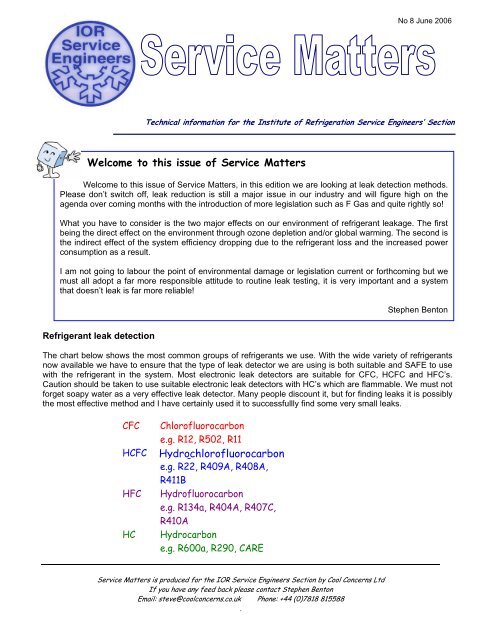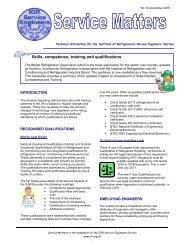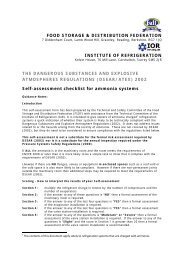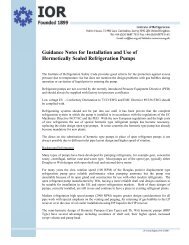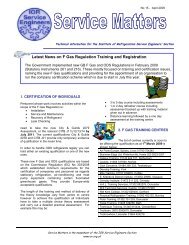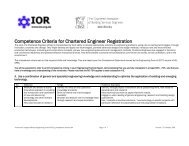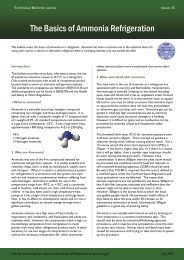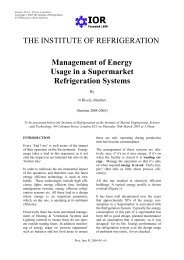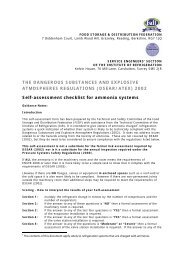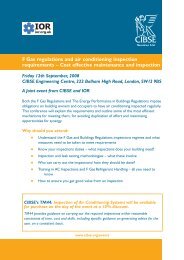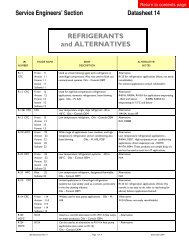Leak Detection Techniques - Institute of Refrigeration
Leak Detection Techniques - Institute of Refrigeration
Leak Detection Techniques - Institute of Refrigeration
You also want an ePaper? Increase the reach of your titles
YUMPU automatically turns print PDFs into web optimized ePapers that Google loves.
No 8 June 2006<br />
Technical information for the <strong>Institute</strong> <strong>of</strong> <strong>Refrigeration</strong> Service Engineers’ Section<br />
Welcome to this issue <strong>of</strong> Service Matters<br />
Welcome to this issue <strong>of</strong> Service Matters, in this edition we are looking at leak detection methods.<br />
Please don’t switch <strong>of</strong>f, leak reduction is still a major issue in our industry and will figure high on the<br />
agenda over coming months with the introduction <strong>of</strong> more legislation such as F Gas and quite rightly so!<br />
What you have to consider is the two major effects on our environment <strong>of</strong> refrigerant leakage. The first<br />
being the direct effect on the environment through ozone depletion and/or global warming. The second is<br />
the indirect effect <strong>of</strong> the system efficiency dropping due to the refrigerant loss and the increased power<br />
consumption as a result.<br />
I am not going to labour the point <strong>of</strong> environmental damage or legislation current or forthcoming but we<br />
must all adopt a far more responsible attitude to routine leak testing, it is very important and a system<br />
that doesn’t leak is far more reliable!<br />
Stephen Benton<br />
Refrigerant leak detection<br />
The chart below shows the most common groups <strong>of</strong> refrigerants we use. With the wide variety <strong>of</strong> refrigerants<br />
now available we have to ensure that the type <strong>of</strong> leak detector we are using is both suitable and SAFE to use<br />
with the refrigerant in the system. Most electronic leak detectors are suitable for CFC, HCFC and HFC’s.<br />
Caution should be taken to use suitable electronic leak detectors with HC’s which are flammable. We must not<br />
forget soapy water as a very effective leak detector. Many people discount it, but for finding leaks it is possibly<br />
the most effective method and I have certainly used it to successfullly find some very small leaks.<br />
CFC<br />
HCFC<br />
HFC<br />
HC<br />
Chlor<strong>of</strong>luorocarbon<br />
e.g. R12, R502, R11<br />
Hydrochlor<strong>of</strong>luorocarbon<br />
Hydrogenated CFC<br />
e.g. R22, R409A, R408A,<br />
R411B<br />
Hydr<strong>of</strong>luorocarbon<br />
e.g. R134a, R404A, R407C,<br />
R410A<br />
Hydrocarbon<br />
e.g. R600a, R290, CARE<br />
Service Matters is produced for the IOR Service Engineers Section by Cool Concerns Ltd<br />
If you have any feed back please contact Stephen Benton<br />
Email: steve@coolconcerns.co.uk Phone: +44 (0)7818 815588<br />
.
No 8 June 2006<br />
The below table gives an overview <strong>of</strong> leak detectors and their suitability for different types <strong>of</strong> refrigerant.<br />
Extra care should be taken when selecting an electronic detector for Hydrocarbon (HC) refrigerants. If in doubt<br />
don’t use an electronic detector - use soap and water.<br />
HCFCs HFCs HCs<br />
Electronic leak detector Yes Yes ??? - Check<br />
Infra-red leak detector Yes Yes ??? – Check<br />
Halide leak detector Yes No No<br />
Fluorescent additives Yes Yes Yes<br />
Ultra sonic leak detector Yes Yes Yes<br />
Soapy water Yes Yes Yes<br />
1. Electronic leak detectors: -<br />
For the most part, there are just four types <strong>of</strong> electronic leak detectors.<br />
• Corona discharge<br />
• Heated diode<br />
• Infrared<br />
• Ultrasonic<br />
Corona discharge detectors pull air through an electrical field (corona discharge) around a<br />
wire. The presence <strong>of</strong> refrigerant or other gases in the air changes the current in the wire and<br />
triggers an alarm. The problem with this is that it’s not compound specific so any substance<br />
the leak detector senses could give false alarms including cleaning chemicals. Not HC<br />
suitable!<br />
Heated diode detectors use a heated ceramic diode. The diode generates an electrical<br />
current when it comes into contact with halogenated gas which the electronics convert into<br />
an alarm. The heated diode sensor is sensitive to contamination, especially from moisture or<br />
oil and will need replacement after approximately 100 hours <strong>of</strong> operation. This type <strong>of</strong><br />
detector is much less likely to give false alarms and works especially well with R134a. The<br />
more expensive models have their own built in sensitivity check mode to ensure the sensing<br />
head is actually working. Not HC suitable!<br />
Service Matters is produced for the IOR Service Engineers Section by Cool Concerns Ltd<br />
If you have any feed back please contact Stephen Benton<br />
Email: steve@coolconcerns.co.uk Phone: +44 (0)7818 815588<br />
.
No 8 June 2006<br />
Infrared detectors have an optical bench that the refrigerant passes through. The<br />
refrigerant absorbs IR radiation. The bench senses this and converts it into an alarm<br />
dependant on the amount <strong>of</strong> IR absorbed. The technology is very accurate and less<br />
prone to contamination. It has only been recently deployed in small hand held<br />
technology but has been widely used in larger fixed environmental detectors for many<br />
years. Check with manufacturer before using with HC’s.<br />
Ultrasonic detectors work on sound waves emitted when gas or vacuum escapes<br />
through a small orifice (leak). The sound is well above the frequencies sensitive to<br />
the human ear. The electronics pick up these frequencies and amplify them into an<br />
audible output that we can hear. The technology isn’t new but has only recently<br />
become cheap enough to use in hand held leak detectors. The notable benefit <strong>of</strong> this<br />
type <strong>of</strong> detector is it will detect any gas or vacuum leak including nitrogen and HC<br />
refrigerants. Service Matters will cover this type <strong>of</strong> technology in a later issue.<br />
Suitable for HC’s.<br />
An alternative that can prove very useful for locating pin holes in areas such as<br />
evaporator tube ends is either a medical stethoscope with the diaphragm removed or<br />
a length <strong>of</strong> nylon tube held close to the ear; this simply amplifies the noise source <strong>of</strong><br />
the leak.<br />
2. Other leak detectors: -<br />
Halide detectors were very popular for use with CFC and HCFC refrigerants. The detector was normally<br />
powered with butane and worked in a similar way to a Bunsen burner. The air was channelled into the flame<br />
via a rubber tube connected below the flame. As air with refrigerant passed through the flame the chlorine<br />
element turned the flame from normal to green through to bright blue dependant on the refrigerant content <strong>of</strong><br />
the air. Be aware that the by-products <strong>of</strong> burning refrigerants are highly toxic. DO NOT USE this type <strong>of</strong> leak<br />
detector with HFC’s or HC’s!<br />
Service Matters is produced for the IOR Service Engineers Section by Cool Concerns Ltd<br />
If you have any feed back please contact Stephen Benton<br />
Email: steve@coolconcerns.co.uk Phone: +44 (0)7818 815588<br />
.
No 8 June 2006<br />
Fluorescent (UV) detectors use an additive which is added to the oil in a<br />
system. It travels around with the oil and can be detected using ultra<br />
violet (UV) light where it has leaked from the system. The hand held UV<br />
kits come in various forms typically consisting <strong>of</strong> a UV lamp, additive<br />
injection kits and polarising goggles. The system relies on the oil leaking<br />
from the system (with additive) though in some cases oil separators<br />
almost totally remove the additive as it leaves the pack or condensing<br />
unit rendering it useless around the remainder <strong>of</strong> the system. Almost all<br />
car manufacturers charge this additive with the refrigerant into car A/C<br />
systems and some gas manufacturers supply refrigerant with the<br />
additive included. Suitable for HC’s.<br />
Soap & Water may be used to test for refrigerant leaks. Make soap and water solution by mixing liquid soap<br />
(washing up liquid) with water into a thick consistency. Let it stand until the bubbles have dispersed, and then<br />
apply it to the suspected leak with a s<strong>of</strong>t brush. A leak will cause bubbles to appear under the soap solution.<br />
Care should be taken that a system is not on a vacuum before using this method as it could be drawn into the<br />
system with obvious results. Soap and water is ineffective on suction lines operation below freezing. <strong>Leak</strong><br />
detection spray is also widely available in aerosol cans or manual pump spray guns. Suitable for HC’s.<br />
3. <strong>Leak</strong> Detector Maintenance<br />
Having selected the appropriate leak detector for the job it is important to be sure the equipment is working.<br />
Most <strong>of</strong> the electronic leak detectors need regular calibration and the corona discharge and heated diode<br />
types require sensor changes at regular intervals. Read the manufacturers instructions as a leak detector that<br />
is not working is not obvious to the user. DO NOT open a bottle <strong>of</strong> refrigerant over your detector head to prove<br />
that it is working - even a sensor that is spent will sense that, come to that so would you!<br />
4. <strong>Leak</strong> <strong>Detection</strong> Technique<br />
Having the right leak detector and checking its operation technique could mean the difference between finding<br />
a leak and missing it. I have bulleted below the main points to successful leak detection especially when using<br />
electronic leak detectors. They are not in priority order but will all add up to successful hunting: -<br />
• Don’t under estimate visual leak detection, look for oil traces – use your eyes;<br />
• Ensure you have the correct leak detector for the job and it is operating correctly;<br />
• Move the electronic detector sensing tip slowly over the area being tested in a constant motion;<br />
• If you sense a leak move back and forth over the area until you zero in on the leak. If you simply point<br />
the detector at a suspected leak it will zero out and you might miss it;<br />
• Refrigerants are heavier than air so it is always worth a quick swoop <strong>of</strong> the cold room floor or cabinet<br />
base, watch out for any water or oil though! It might give you a quick indicator if you are in the right<br />
area;<br />
• Do not trust electronics alone. If your leak detector has indicated something use soapy water to zero in<br />
on it. Use a mix <strong>of</strong> technologies. They all work, some better than others dependant on the environment<br />
and no one technology is best!<br />
If you have any questions on leak detection please contact us.<br />
Happy Hunting!<br />
Service Matters is produced for the IOR Service Engineers Section by Cool Concerns Ltd<br />
If you have any feed back please contact Stephen Benton<br />
Email: steve@coolconcerns.co.uk Phone: +44 (0)7818 815588<br />
.


